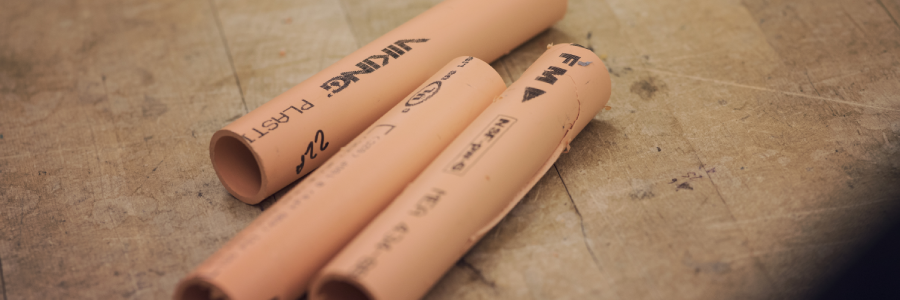Failure Analysis Testing: Identifying Field Issues
One of the value-added services that BlazeMaster® CPVC offers is that of failure analysis. We recognize that there are occasional issues in the field. It is in everyone’s best interest that the root cause of the problem be determined to help prevent it from re-occurring.
Sections of pipe or fittings are sent to us from the product manufacturer for failure analysis. It is helpful not only to receive the physical specimen, but also information about how and where it was installed, what materials it may have been in contact with such as insulation or wiring, or whether chemicals – such as mold inhibitors – had been sprayed in the building.
Physical Examination First; Chemical Examination Second
As we perform our physical examination, we document the findings with photography. Taking the additional information provided into account, we first examine the returned part to determine the point of failure. Sometimes, it’s obvious – there may be a large crack that is not too hard to find. If the point of failure is not obvious, we will examine the pipe under a microscope or pressurize it with water to try to make it leak.
We’ll also look at external clues, such as the orientation of how the pipe was installed. For example, it makes a difference if the failure was oriented along the top or bottom of the pipe. If there are random chemicals inside the pipe such as oil – which will float along the top of the water – failure will occur along the top side. Conversely, if a mold inhibiting chemical has been sprayed around the building, droplets may hang from the bottom of the pipe, causing failure on the bottom – usually first along the fitting, which is typically under a higher stress than the pipe due to its tapered fit. Once a pipe is inserted into the fitting, the fitting becomes strained. The stress makes the fitting even more vulnerable to incompatible chemicals. Even if installation orientation background is not provided to us, we’ll do our best to determine things from cement drips or leak stains on the pipe’s outer diameter.
Next, we cut the pipe or fitting apart to look at the fracture surfaces. Examination of the fracture surface is known as fractography. Various features on the fracture surface reveal a lot about how the crack occurred. We determine if the pipe cracked from the exterior inward or from the interior outward. We want to see if there was more than one point of initiation. We can usually tell by appearance whether the issue was a mechanical issue – crushing or impact damage, handling damage, or cracks that occur if the pipe was cut improperly – versus a chemical issue, or a combination of the two. We can also tell whether it was a fast or slow occurring crack. If it was a chemically-induced crack, certain features of the fracture surface can also inform us which type of chemical was likely to have been involved.
If the issue was mechanical, we document our findings showing the fracture surface and mechanical damage, then issue a report.
If the issue appears to be caused by chemicals, we begin trying to identify them with Fourier-transform infrared spectroscopy (FTIR). This is a basic technique for identifying unknown chemicals by measuring their absorption of infrared light frequencies. It can be conducted by pressing the specimen against a crystal, or washing chemicals off the fracture surface, concentrating on a crystal and performing analysis separately from the CPVC. Often this technique provides enough information to identify the chemicals causing the issue. However, it is often not sensitive enough to detect very low levels of chemicals. When a mixture of chemicals is involved, FTIR may not be able to identify its specific components.
When analysis by FTIR is inconclusive, the next step is usually electrospray ionization mass spectrometry, a test that is extremely sensitive and accurate. It can detect much lower levels of residue, resolve mixtures, and precisely identify individual components.
Once the chemical analysis is complete, the information can be combined with the physical observations and fractography to create a report on the cause of failure.
Often, the source of the particular chemicals identified is not known at the time of the failure analysis. Using information such as the particular combination of chemicals identified, where they were found on the pipe, and the fact that it is likely a substance used in construction or normal occupation of a building, a set of possible sources can often be identified. This assists the contractor in locating and hopefully eliminating the source of the problem.
Preventing Problems Before They Occur
The value of a proper failure analysis does not end by identifying and fixing one particular problem in one specific building. The BlazeMaster team uses the information gained from providing this service to update and improve installation instructions and guidance as well as chemical compatibility recommendations.
Mechanical issues cause approximately 50 percent of failure. Following installation best practices – proper storage and handling, good cutting and joining habits and proper use of solvent cement – can eliminate many of these problems.
Familiarity with the Lubrizol Advanced Materials FBCTM System Compatible Program can help to eliminate the guesswork associated with chemical compatibility. It not only lists compatible products, but incompatible products. It also provides a forum to discuss other chemical compatibility topics.
But that’s not always enough. Once the installation is completed, it is important that the building owner and those responsible for maintenance realize that chemical compatibility issues can lead to system failure. That is where jobsite documents can be provided to building owners that explain the sprinkler system and note the products that must be avoided. Jobsite posters outlining the same can be obtained from pipe and fitting manufacturers for display in the building’s mechanical room.
Finally, if you have any questions regarding failure analysis, installation best practices or chemical compatibility – we’re here to help. Contact us for more information.


